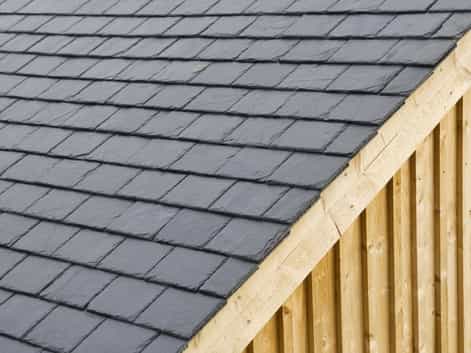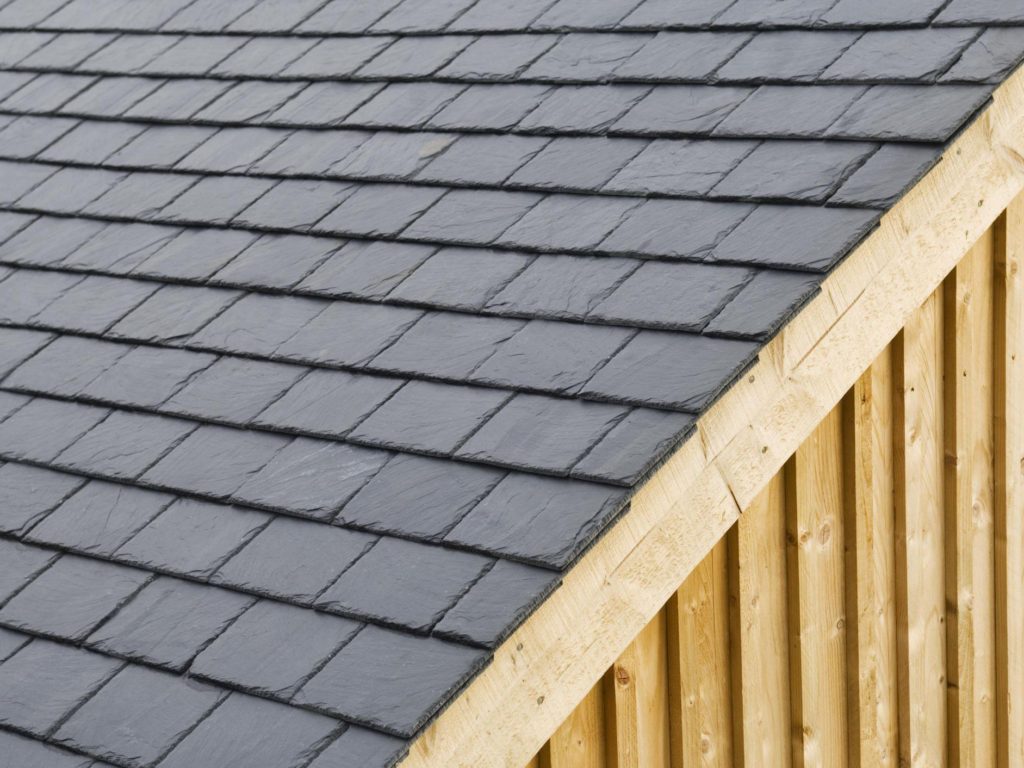Are you considering a new slate roof? Slate roof costs per m2.
Roof replacement is generally difficult to quote exactly as there are a number of factors at play. Of all of the options available, traditional concrete roofing tiles or slate, slate is proving to be a very attractive choice for many people because of its natural beauty and incredible durability. But how much is a new slate roof? Generally, you can expect a slate roof to cost between £40 and £60 per square metre. We have outlined the slate roof costs and factors below.
Last Updated: October 2022
Need a more accurate slate roof quote? Tell us about your project and our local roofers can advise you on the potential costs. Want a quick quote? Fill out the form below. Time to complete: 30 seconds!
Slate is easy to find in the UK and it is a naturally occurring product which is why so many traditional properties throughout the British Isles have slate roofs. The cost per metre for your roof will depend purely and simply on the slate that you choose. It is generally more expensive than concrete tile alternatives.
Slate sourced from Wales, Cornwall or Cumbria seems to have the highest price tag and will set you back on average between £40 and £60 per square metre to which you need to add the labour costs for the work and VAT. The alternative is to import slate from Spain, the world’s leading producer and supplier. This can be cheaper at around £25-£30 per square metre and there are some alternative colour choices as well. You also have the reassurance with Spanish slate that it will meet European standards unlike slate sourced from even further afield; Brazil and China are also suppliers of slate.
It is best to ask your contractor to quote based on the roof area – remember slates are designed to overlap so it can be tricky to work out how many you might need.
What are the cost factors when replacing your current roof with a slate roof?
When working out the cost of re-roofing a house and for a new slate roof, the builder should split his quotation between labour and materials plus there should be a figure for waste disposal of the old roofing materials and scaffolding hire if necessary. Slate is not the cheapest option available and also requires a real degree of skill to fit as a roofing material.
Other slate roof cost factors
There should not be a requirement for planning permission unless your replacing a conservatory roof that is attached to a property which is either listed or within a conservation area or both. The law relaxed in 2010 and permitted solid roofs to come within the definition of a ‘conservatory’ thus removing the requirement to always have a roof which was at least 75% translucent. However, if you do need to apply for planning permission then there will be a fee for this in the region of £200.
If you are opting for a flat ceiling inside the conservatory then you will need to factor in the cost of installation, plastering and the paintwork to finish the job. You may also want to upgrade or renew your rainwater goods so they are more appropriately styled to suit your new slate roof.
Use our roof cost calculator to learn more about how much you may need to budget for your project.
What is a slate roof and why have they become so popular?
Slate roofing is part of a developing trend to fit solid roofs - both slate and tile - to conservatories rather than the traditional glazed or polycarbonate roofs seen in the last couple of decades. A relaxation in the planning laws has made this possible.
Slate is created from a natural rock which is cut into slices and used as roofing material or wall cladding. Its natural rawness is one big element of slate’s renewed appeal both for exteriors and interiors but it also scores highly on its eco-friendly credentials.
Do slate roofs work with conservatories
Slate roofs work very well with conservatories attached to period cottages and Victorian properties which commonly have slate as their main roofing material. However, there are many other advantages to using slate and here are a few of them:
- Slate doesn’t just look good on old-style or traditional homes it can also work very well with a contemporary and urban design. Slate is sleek, naturally cleaved with a chalk-like finish that goes shiny in the rain. Slate has been rediscovered and prized not only for its rough-hewn texture and uneven appearance but also its colour palette, working through from a soft blue-grey to heather purple and nearly black, all shades which are right on trend
- Slate is incredibly tough and durable yet very lightweight and will create a roof which lasts a lifetime with appropriate care
- Slate is a natural material as opposed to manmade alternatives or products made with a less than eco-friendly manufacturing footprint
- Slate, unlike concrete, has a lower tendency to absorb water keeping the roof structure light so slate roofs are suited to cold, wet climates
- Because slate has a low water absorbency, it is resistant to cracking and splitting during frosty conditions and when temperatures are regularly below zero
- Slate tiles are dark coloured in a bluey grey and have quite a high thermal mass which means they absorb heat from the sun well throughout the day and release it at night. Slate is a good insulator
- Slate has good soundproofing qualities
Thanks for reading! We hope you have a better understanding of slate roof costs!
Get a free slate roof quote
See how we work below.

1. Tell us some details of exising roof
Tell us the details of your existing roof and the slate roof you would like.
2. Tell us your UK address
We have a national network of roofers around the United Kingdom. Whether you are in Scotland or London, we can help.
3. Recieve a no obligation quote
You'll receive up to 4 no-obligation quotes and have a better idea of the roof replacement cost.
Are there different types of slate available?
When most people think of slate, they tend to think of natural slate, the sort you see on cottages and homes in Wales and Cornwall. But there is more than one type of slate:
- Natural slate – natural slate is the product with the exceptionally long lifespan and is available in a wide variety of colours depending on the source, this is the most expensive
- Fibre Cement slate – probably the most popular alternative to natural slate largely because of its cost. As well as a wide variety of shades, there are also more choices with regard to style, for example, fibre cement slate is available in diamond shapes. Fibre cement slate does not offer the incredible longevity of natural slate but it does have the advantage of being a lighter material so can be fitted to conservatory roofs without the requirement to upgrade the supporting structure
- Bituminous slate – is made mainly of long bitumen strips or as it is often known, asphalt. These slates are also called roof shingles. They are light and flexible and can be easily cut to size and finish with a smooth appearance like natural slate. The flexibility makes them a good installation choice over eyebrow windows and domed roofs
What is the process of replacing the current roof with a slate roof?
First, the existing roof must be carefully removed. The structure below will need to be in good order before the new slate roof is fitted. There may be a requirement to renew or upgrade sections of the structure.
If your chosen slates are pre-holed, then they will be quicker to install as they can be nailed directly onto the battens. If not, they will all need to be drilled out first. Slate needs to be double-lapped and sometimes treble-lapped so installing a slate roof is a skilled job.
Get quotes from reputable suppliers here
Save 1,000's on your new slate roof project. Get no-obligation quotes today.
Frequently Asked Questions
Will a slate roof add value to my home?
Without a doubt as slate is recognised as one of the highest quality roofing materials and is also currently very fashionable. A slate roof will remain in good order for decades and represents a real investment for the homeowner.
I have seen much cheaper Chinese slate available, is it worth buying?
Chinese slate is one of the cheapest offerings in the slate market with a huge variety of colours but the slate does have a reputation for bleaching and losing its colour. Some slate products from China comply with British Standards – BS EN 12326 which is the appropriate standard for the quality and performance level of slates – but not all.
How long will a slate roof last?
A well-fitting slate roof can easily last a century or more with the correct and proper care. It is not usually the slates that degrade but often the fixing nails which are more vulnerable and if they fail, then, of course, the slate can slip and crack. But the integrity of the slates themselves, particularly natural slate, is phenomenal.
Do slate roofs leak?
No, they are exceptionally watertight and many of the old roofs that you see in different parts of the country were installed with no underlaying material either. However, slate roofs will leak if they are not maintained properly and incurr additional leaky roof repair costs. If the slates have slipped or become broken and not replaced or the flashings have deteriorated then these are two common problems which can result in a leaky roof.
How do you maintain a slate roof?
A slate roof must be kept in a regular maintenance programme to ensure the roof is watertight and continues to do its job. Broken and cracked slates should be replaced and misaligned slates put back into their correct positioning. Only copper nails should be used. If you have roof lights or Velux windows then pay particular attention to the flashings around these as this is a vulnerable point for ingress of water.
Can I seal my slate roof?
This is not advisable as it makes the slate roof almost impossible to repair and very hard to find leaks if they occur. The coatings available only offer a short-term solution before they need to be renewed and they interfere completely with the slates’ natural ability to do its job.
Can I clean my slate roof?
You can clean the slates of moss and debris but it is recommended that you don’t use a pressure washer or any harsh industrial chemicals as both of these can damage the slate. Use a hand brush and a mild soapy cleaner or a proprietary stone cleaner being sure to rinse away the soap. For more information, take a look at our pages on the cost of roof cleaning and coating and roof moss removal costs.
Can I fit a new slate roof to my conservatory myself?
Natural slate is the roofing material that is probably the trickiest to fit to achieve a good looking and watertight finish and requires specialist installation. Natural slate should be hand-cut and the double or treble lapping procedure does take real skill. Also, if you install the roof yourself then you will not have the benefit of a contractor’s warranty either.
Do I need planning permission to change my old conservatory roof to a new slate roof?
Unless your home is listed or within a conservation area then replacing a glazed or polycarbonate roof on your conservatory with a slate roof should not require an application for planning permission.
How can I finance my new roof?
Many building and roofing contractors now offer finance through a link with a financial services company or bank. It’s rather like buying a new or used car – the finance can be offered at the point of purchase of the contractor’s services. This is an easy way to afford your new roof and payments will vary depending on how much deposit you contribute and how long the finance agreement runs for.
Some property owners seek finance from their mortgage company and use these funds to finance their roof and other improvements around the property. The process for the application of a Further Advance or Home Improvement Loan can be long-winded and drawn out as it is essentially a smaller second mortgage. You will need to have enough equity in your home to support the additional borrowing and be able to demonstrate to your lender that you satisfy their affordability criteria. The loan is likely to run for as long as the remaining term on your original mortgage.
For older property owners who have paid off their mortgage, Equity Release Schemes are often used as a way to fund home improvements.
For more information see guidance from Planning Portal on planning permission and roofs, along with guidance from New Forest District Council on slate roofing and historic properties.



